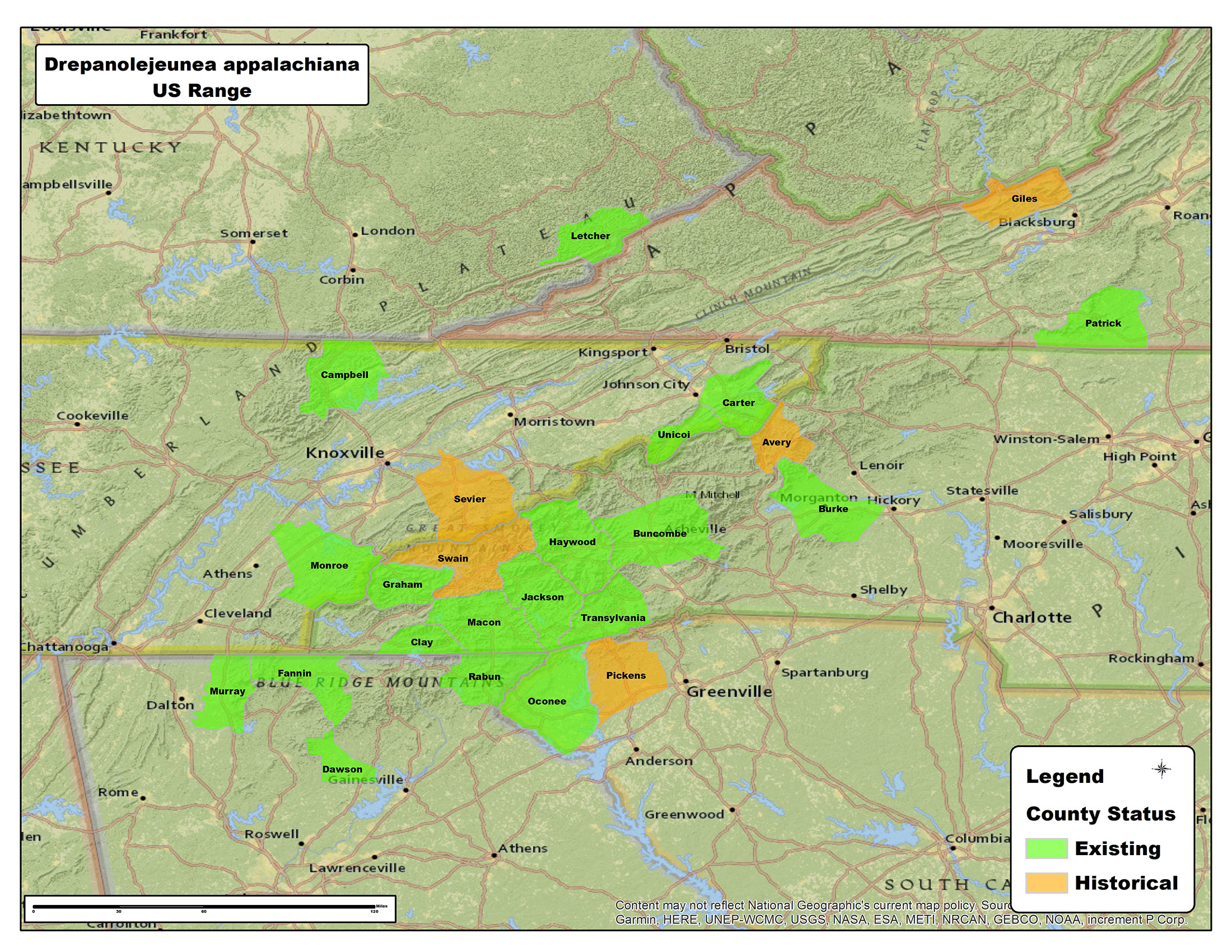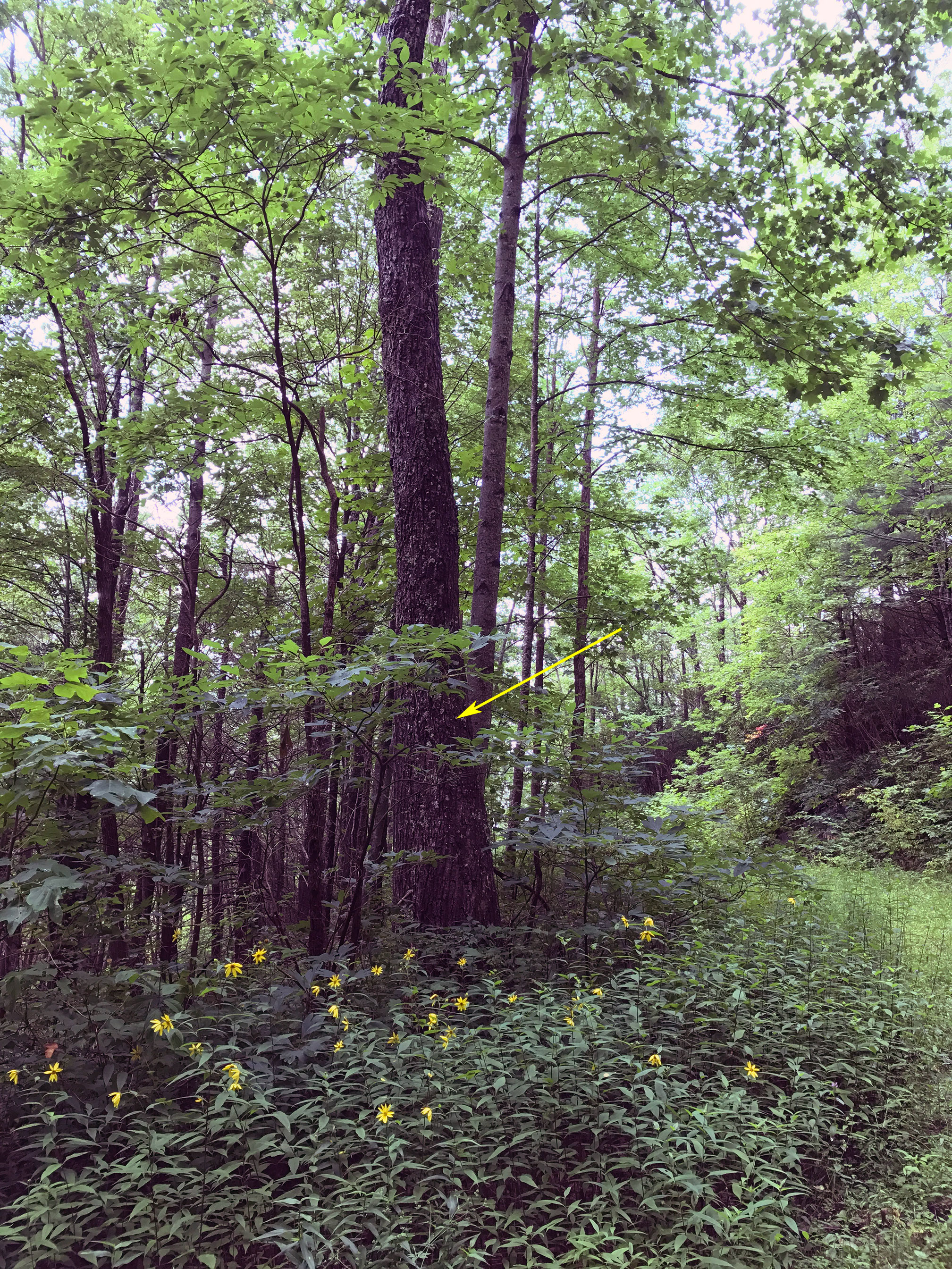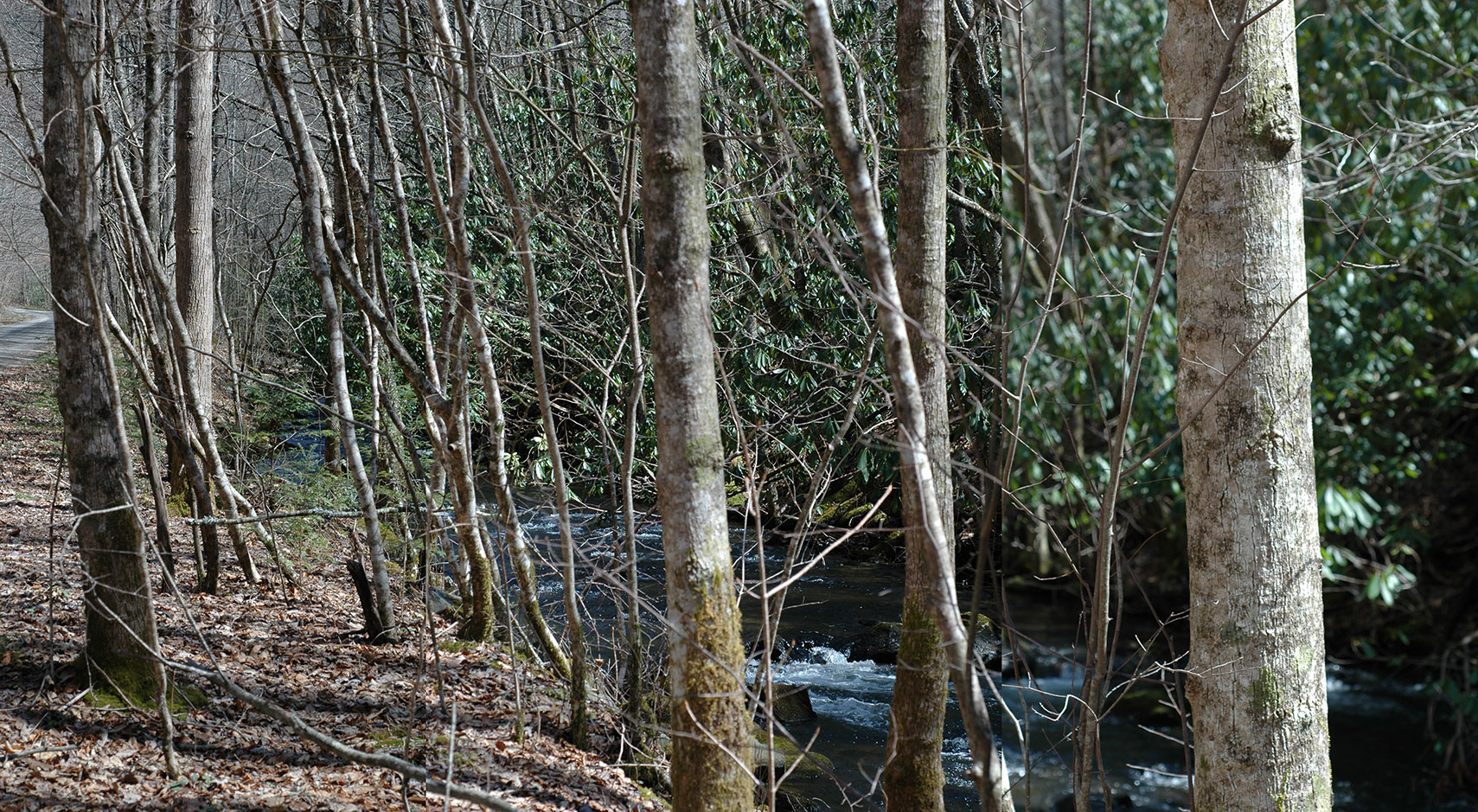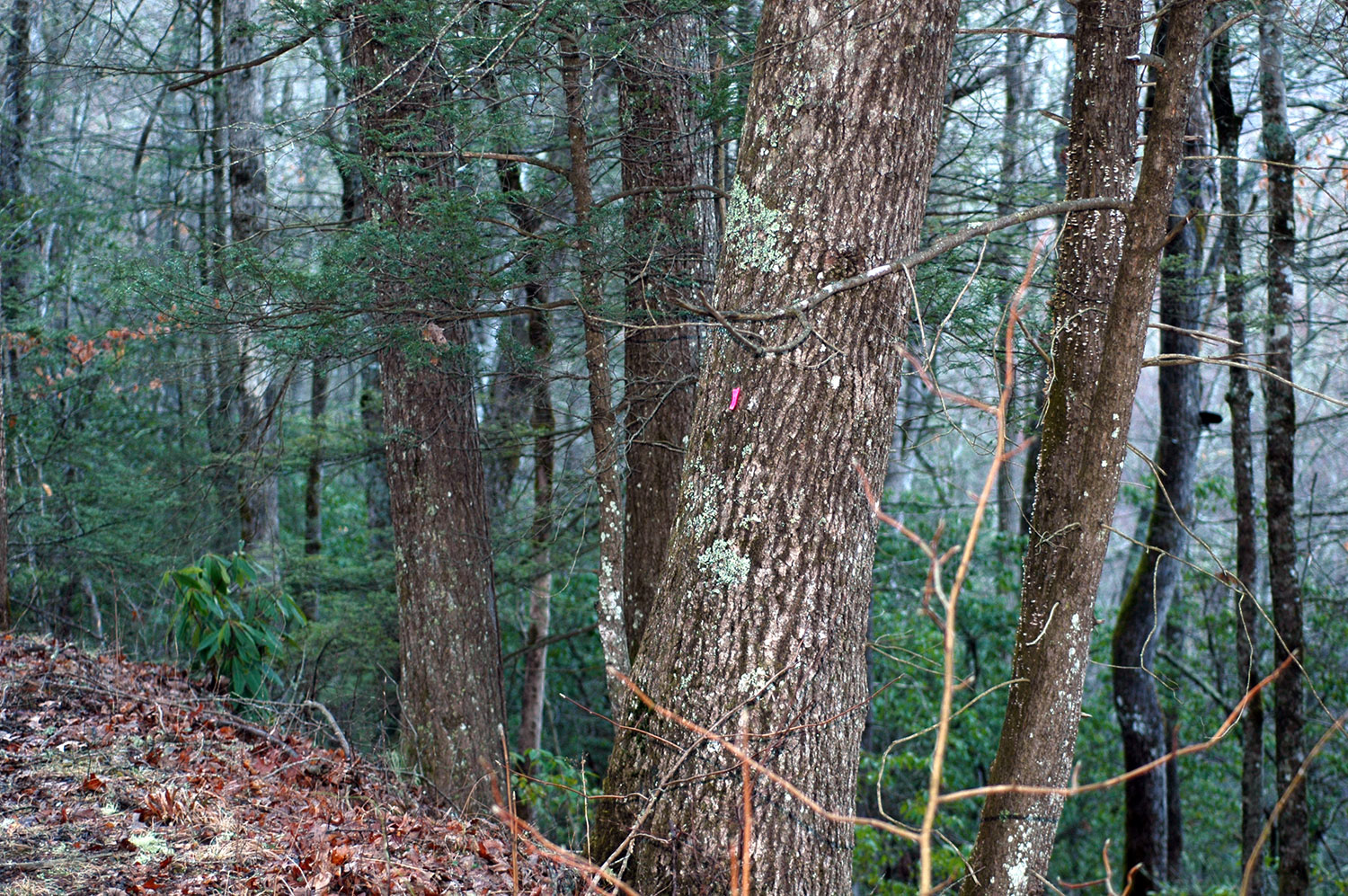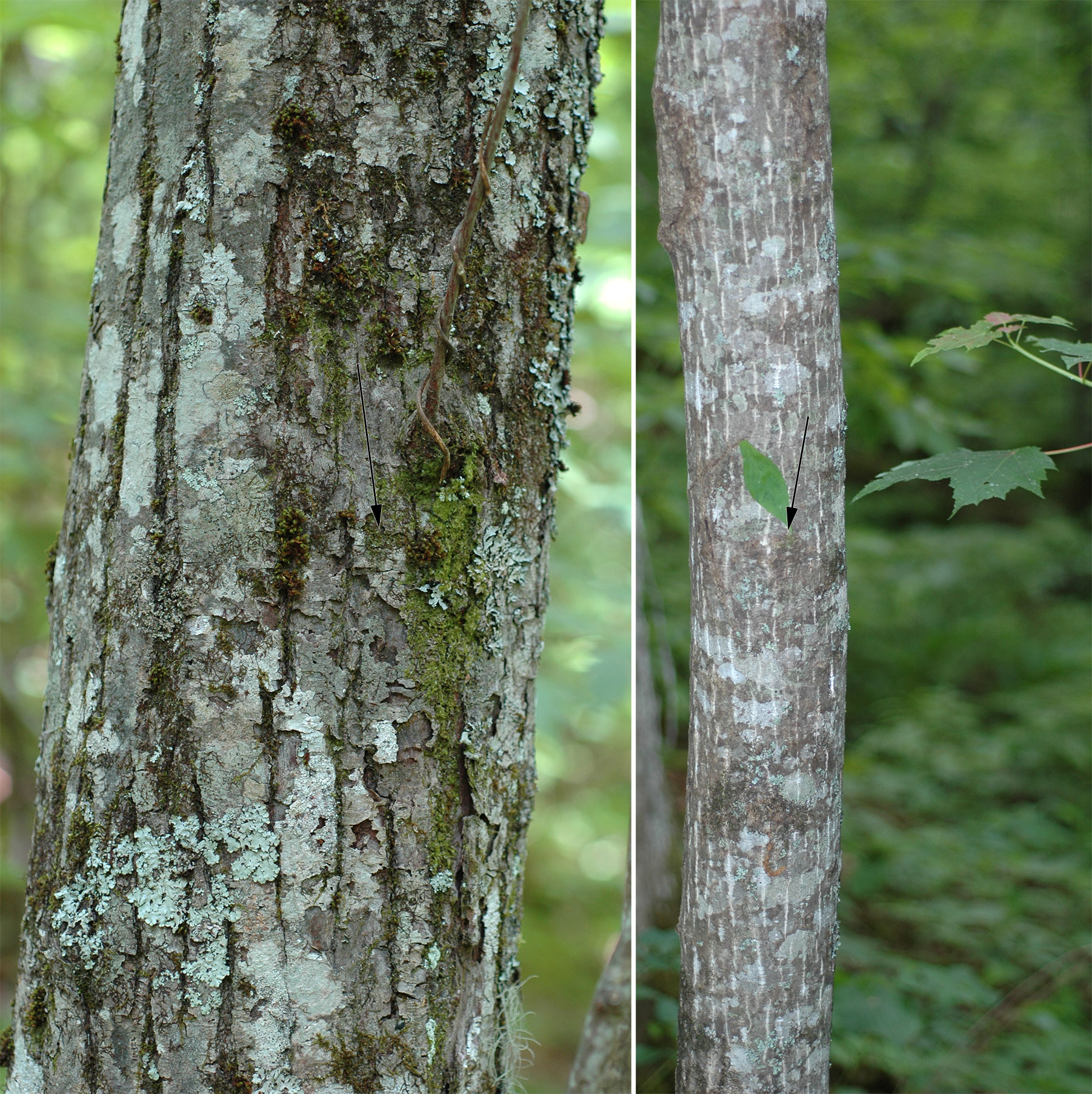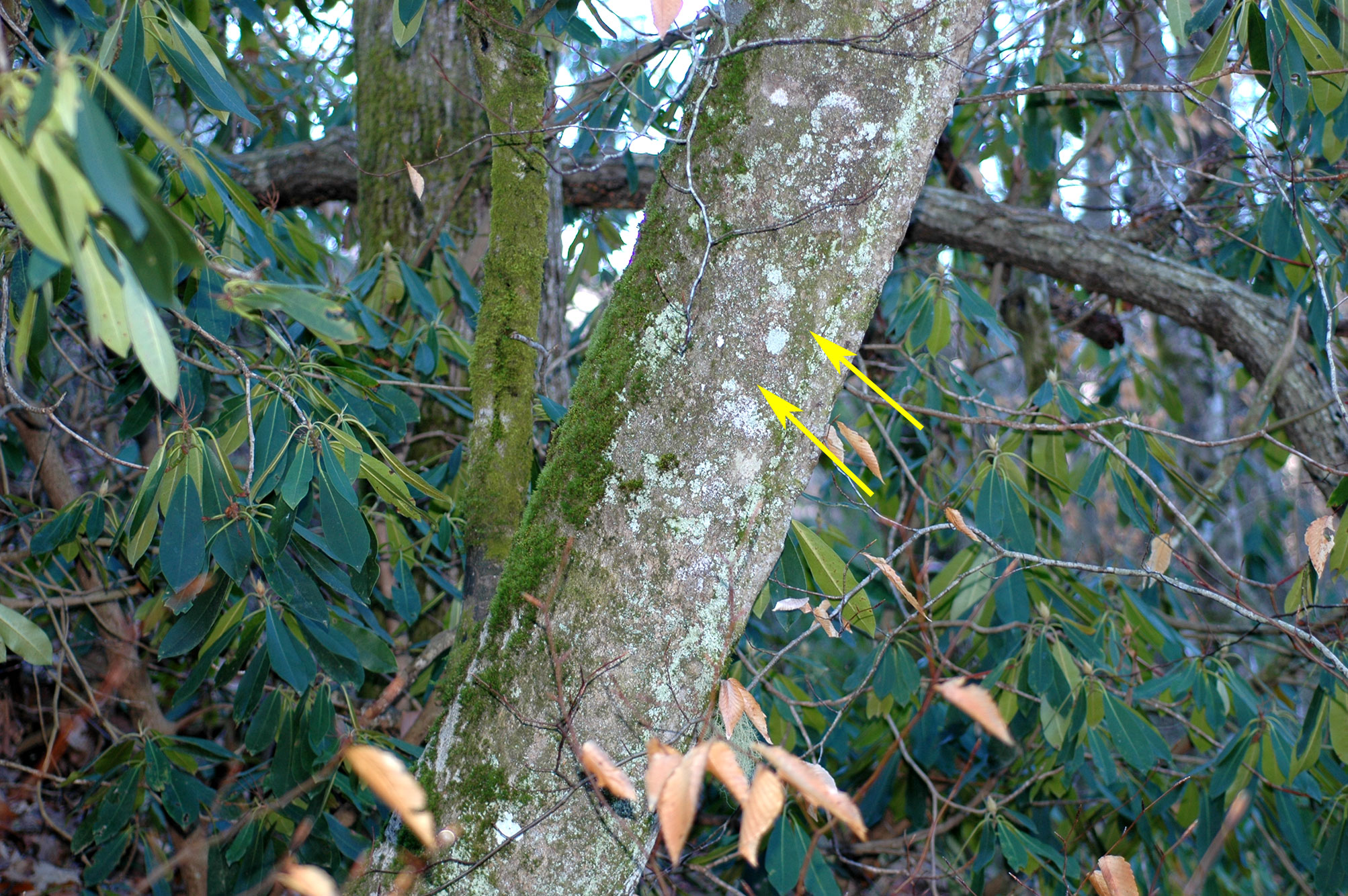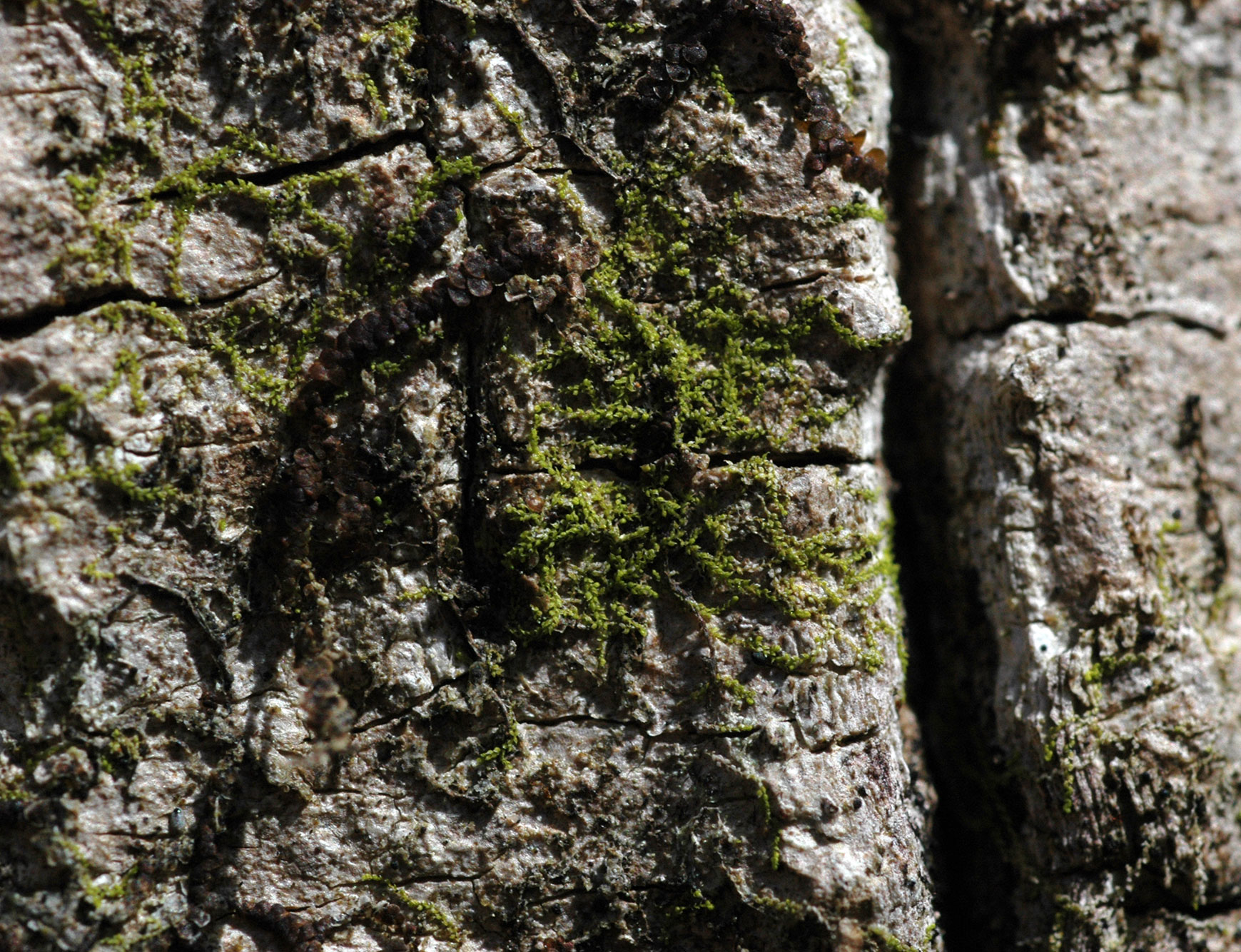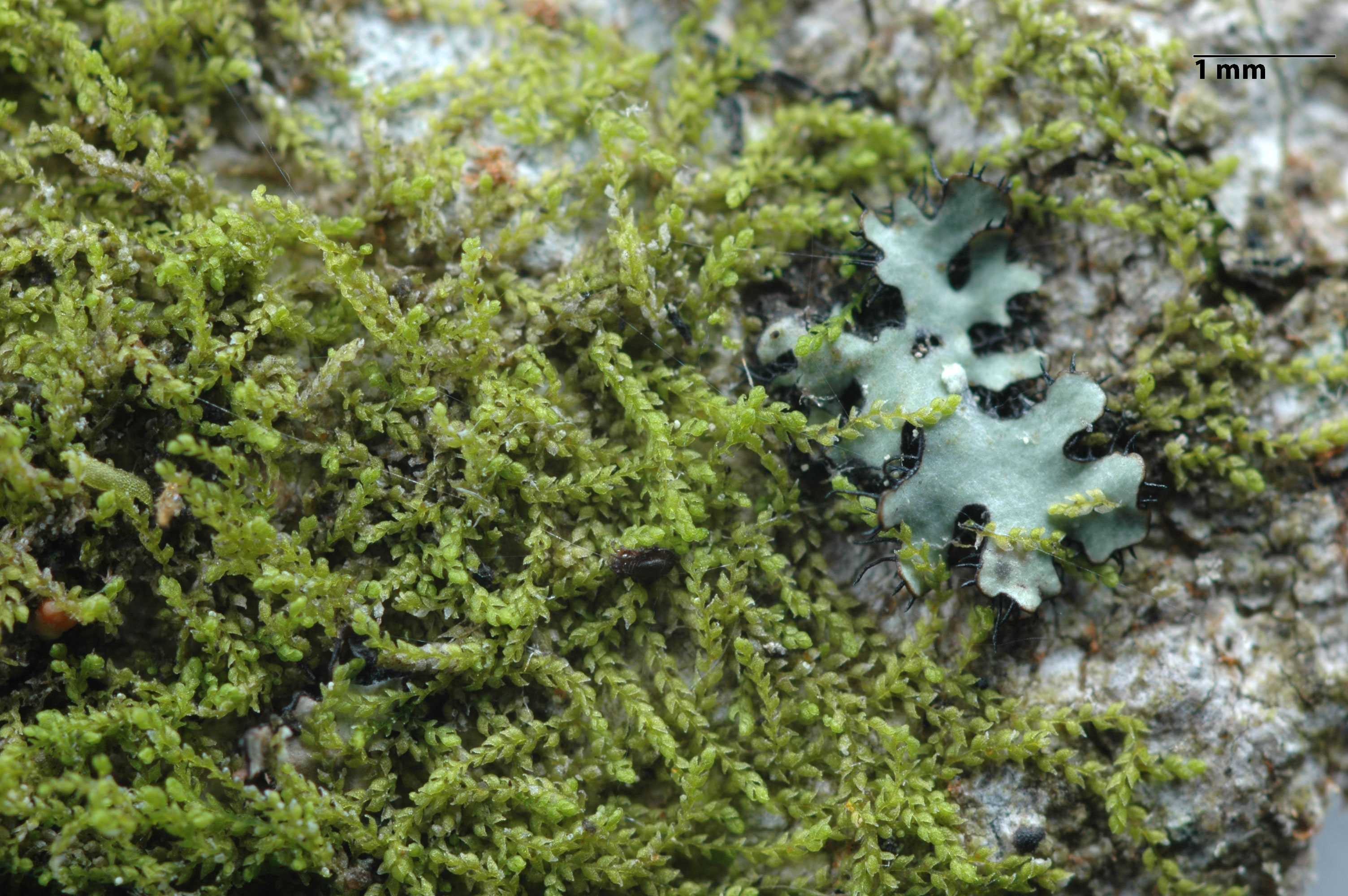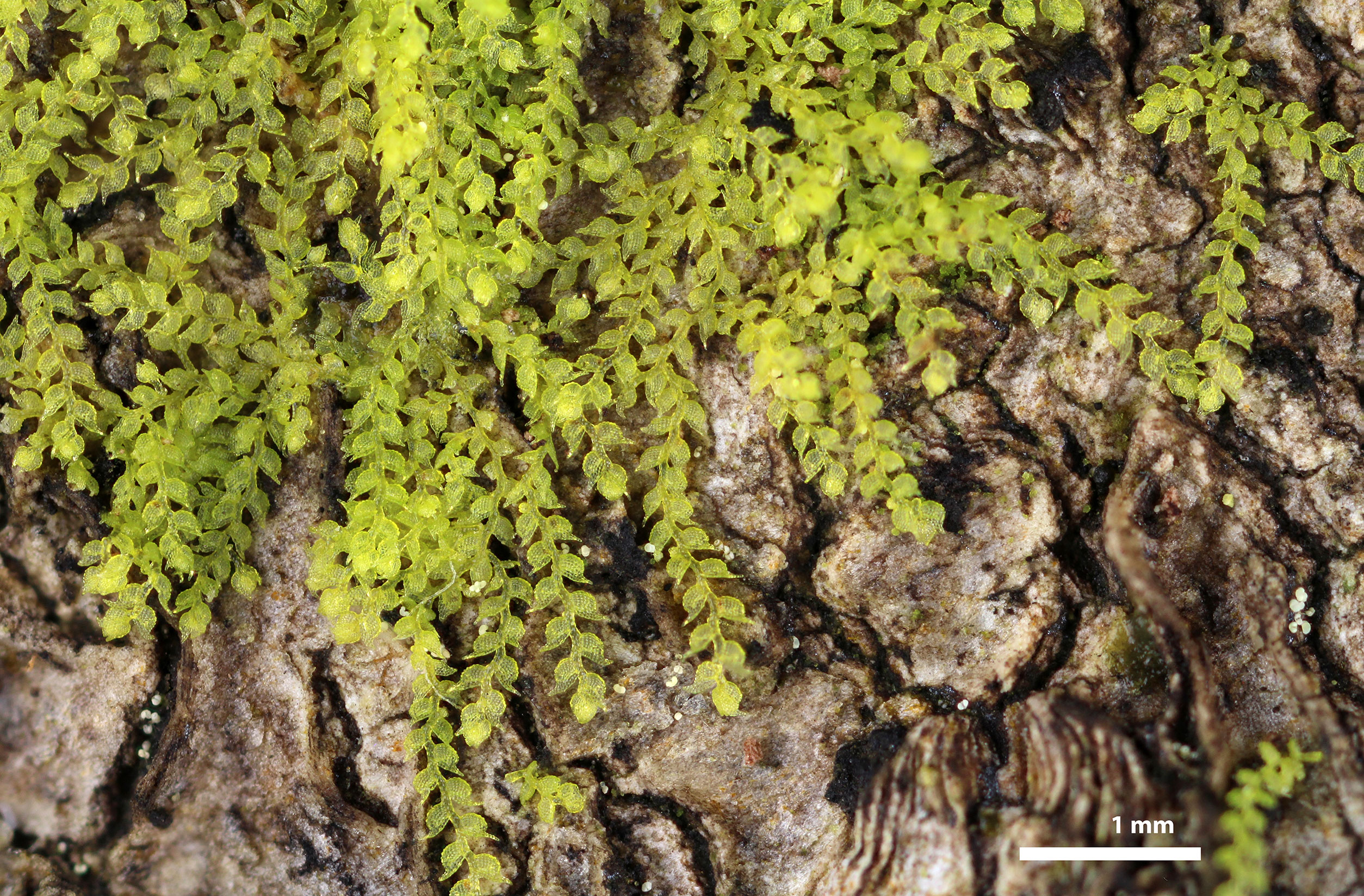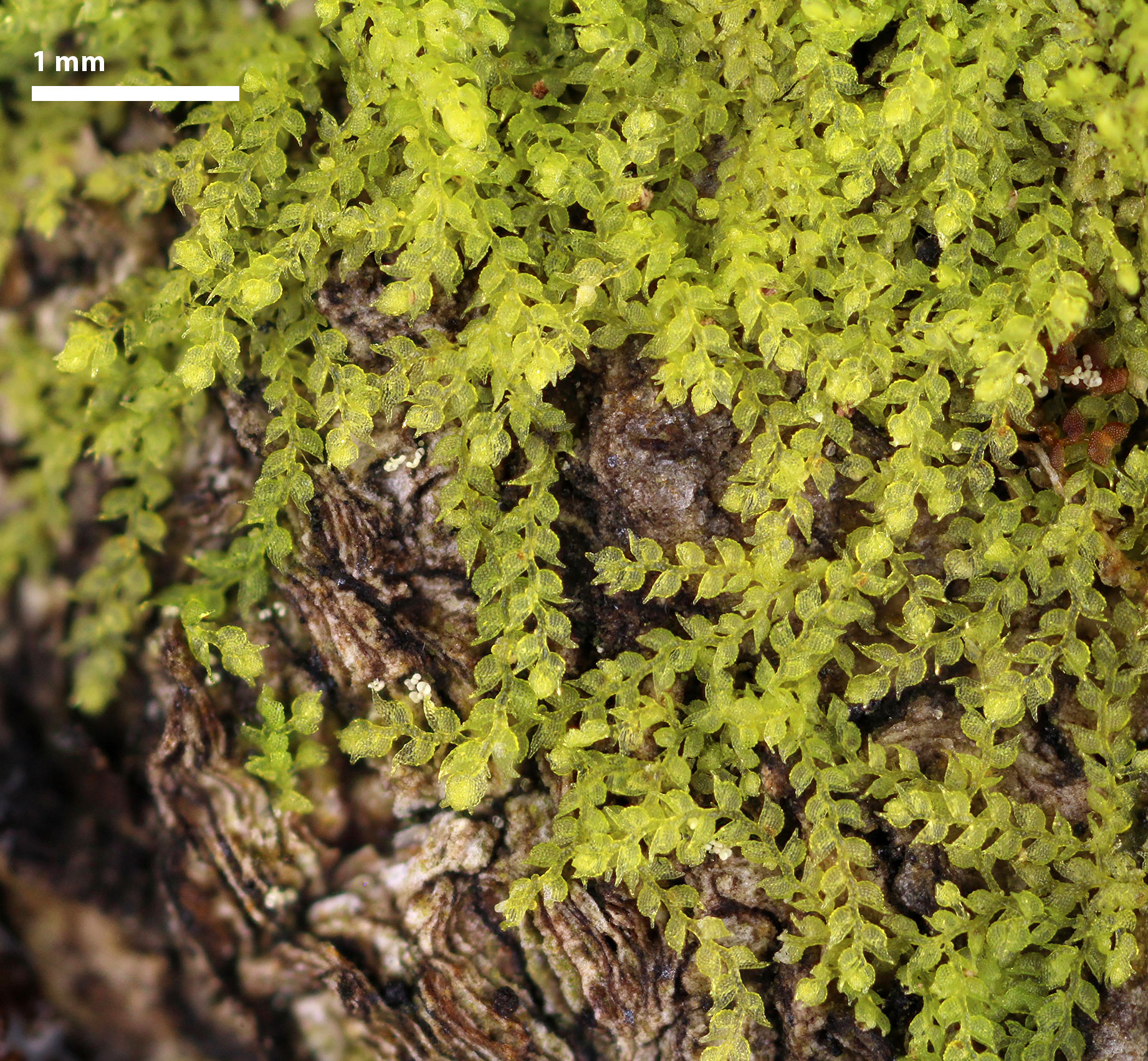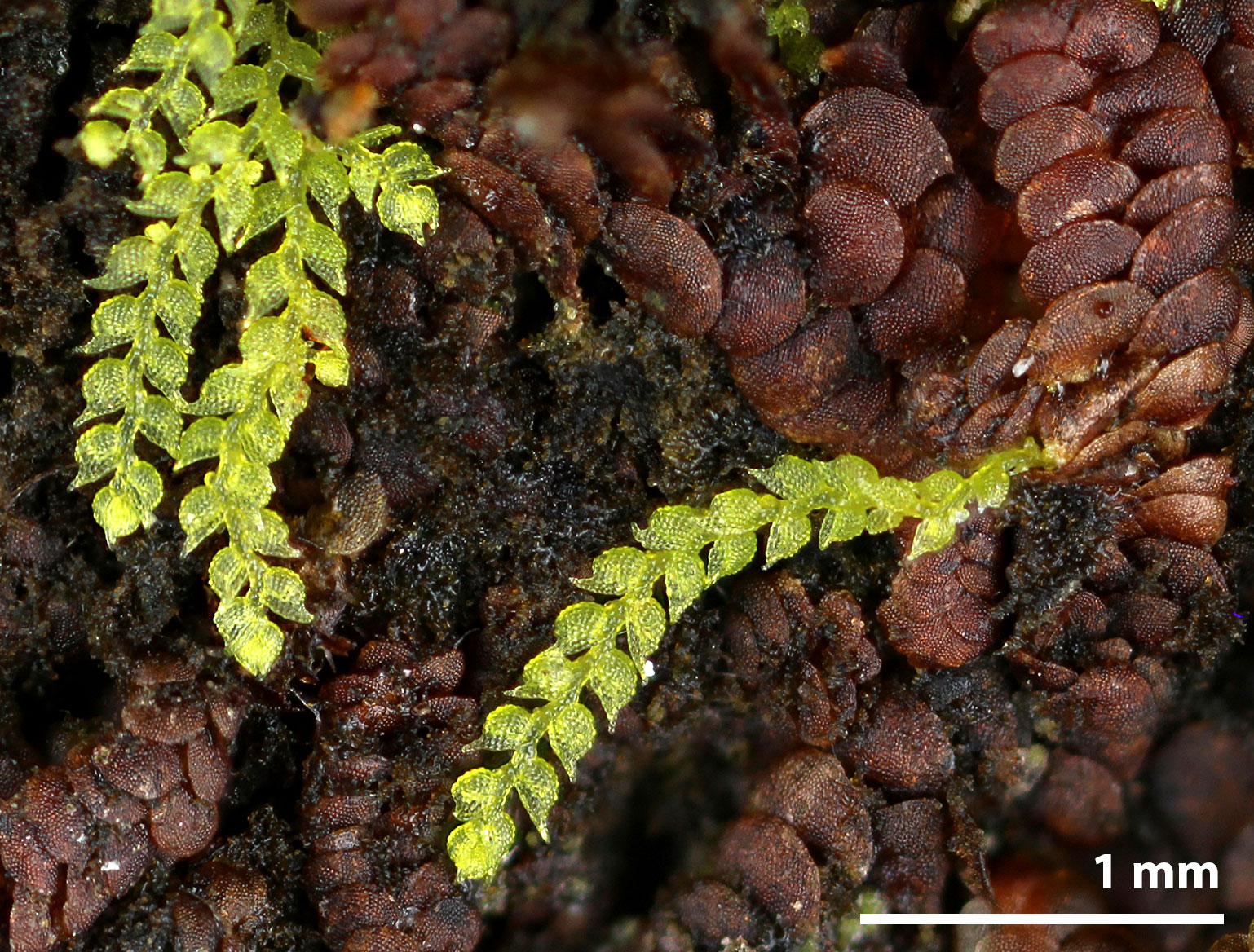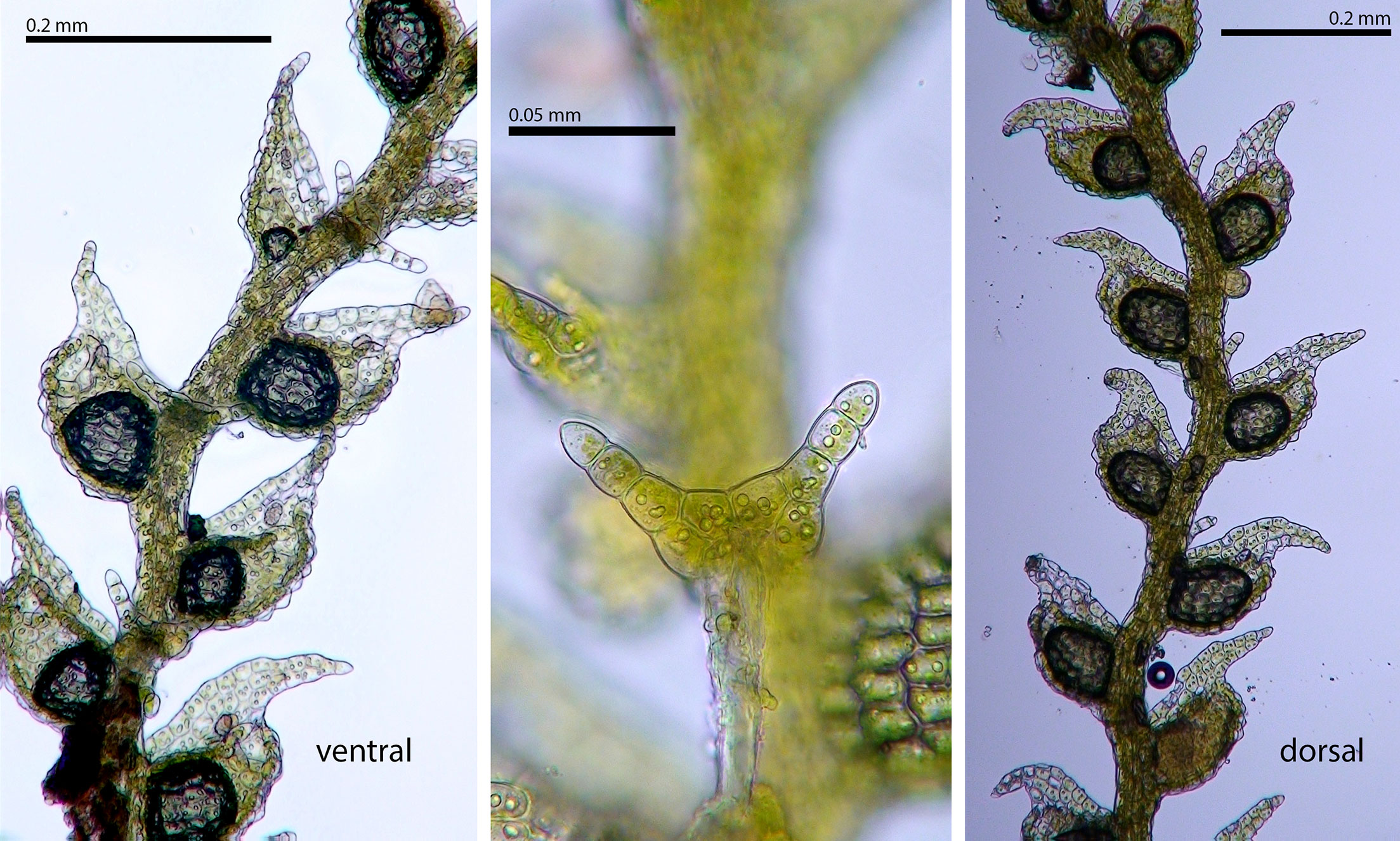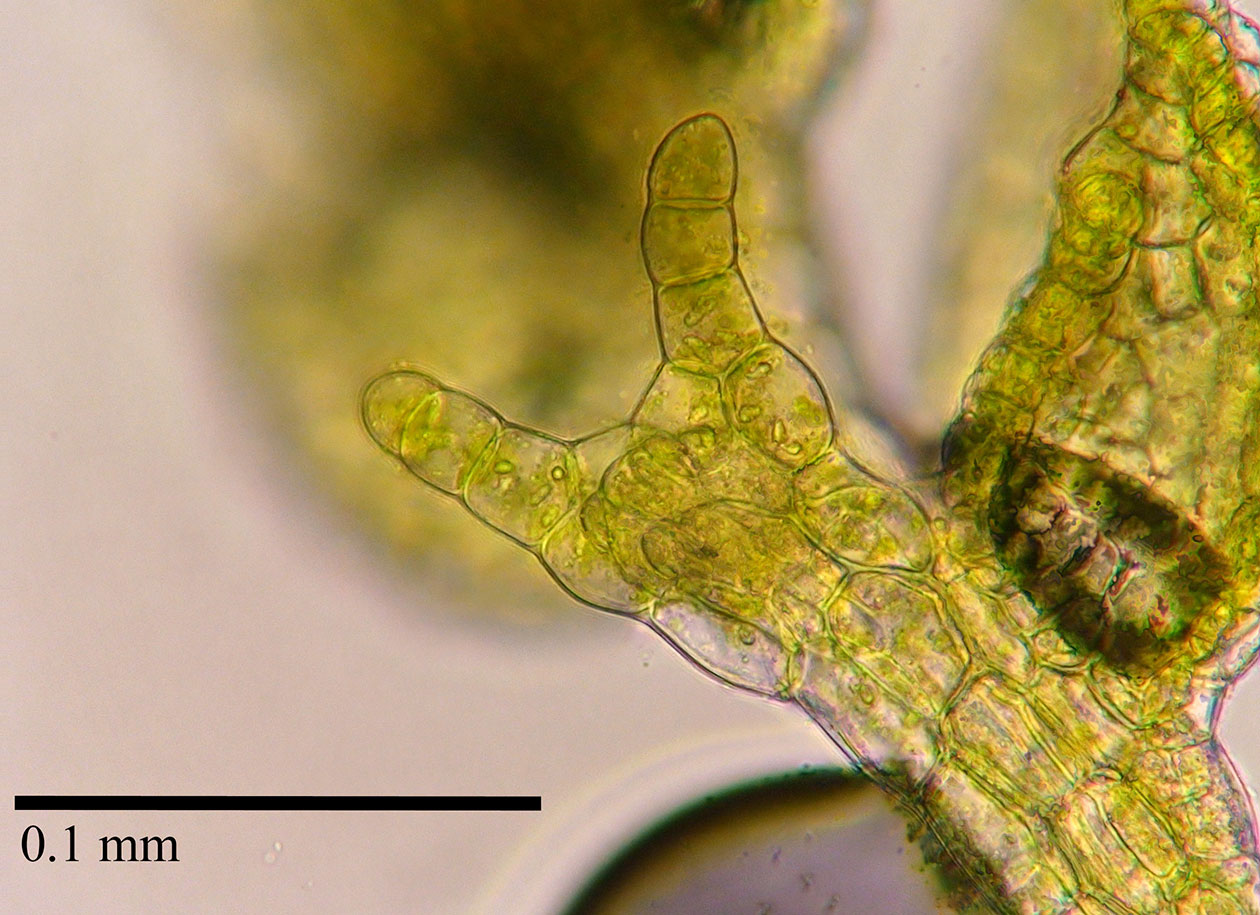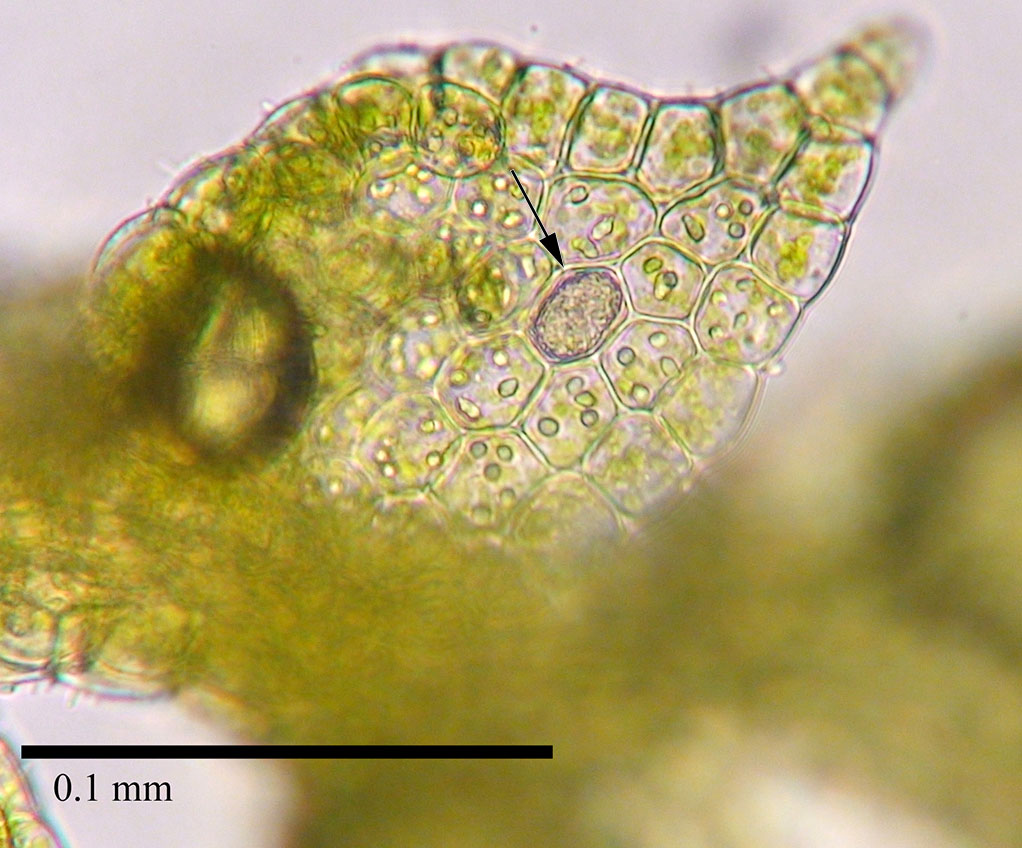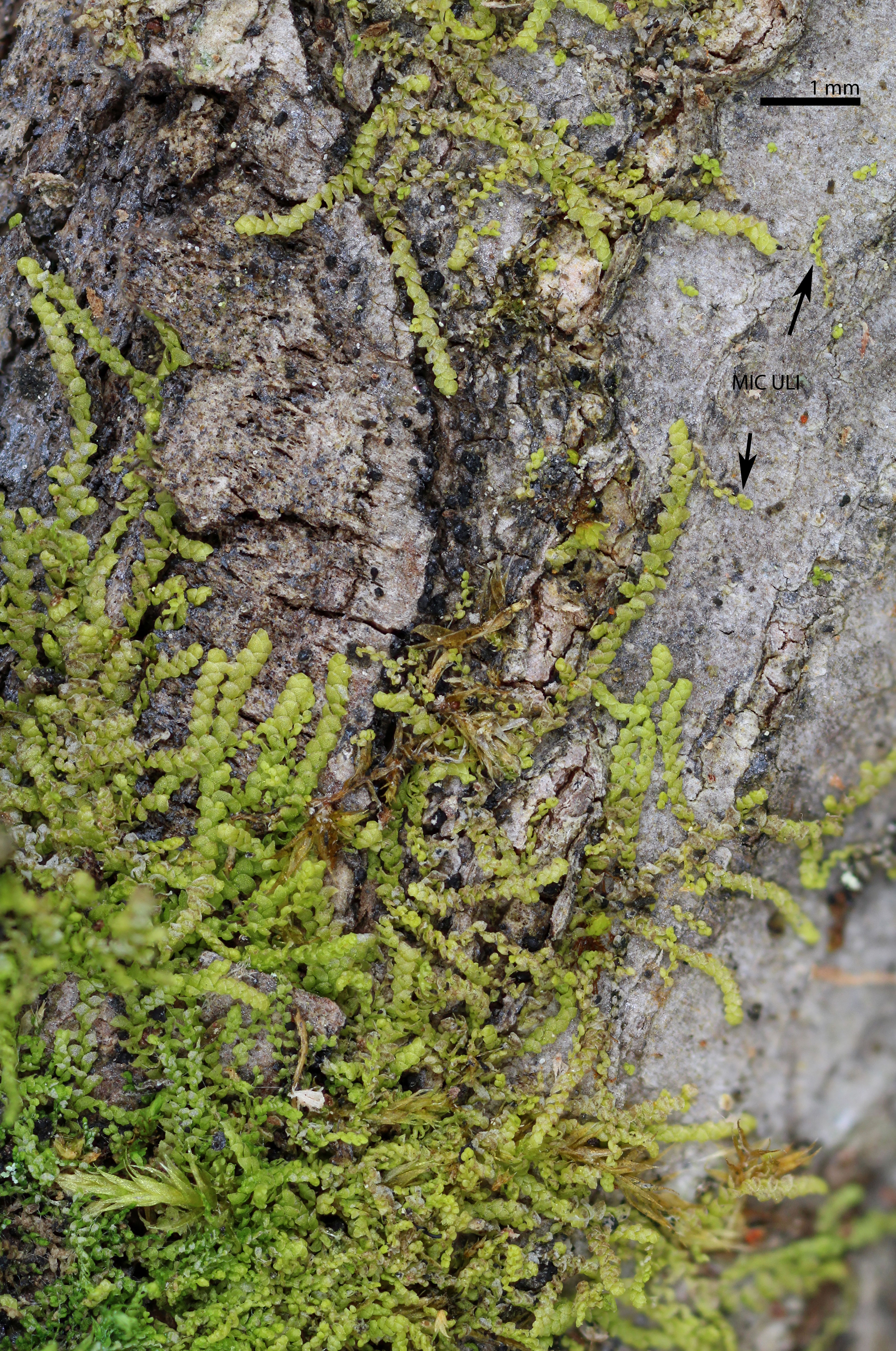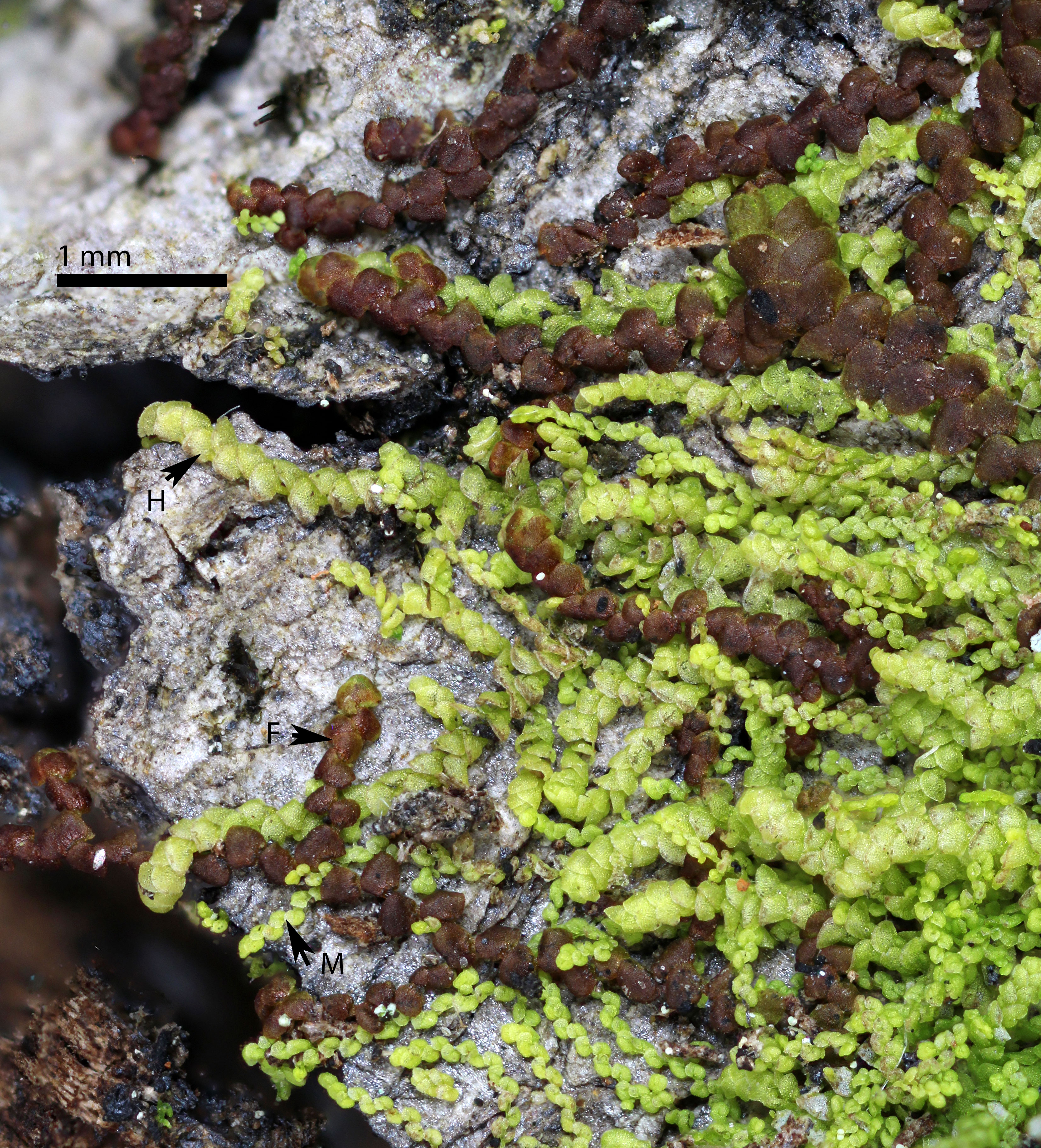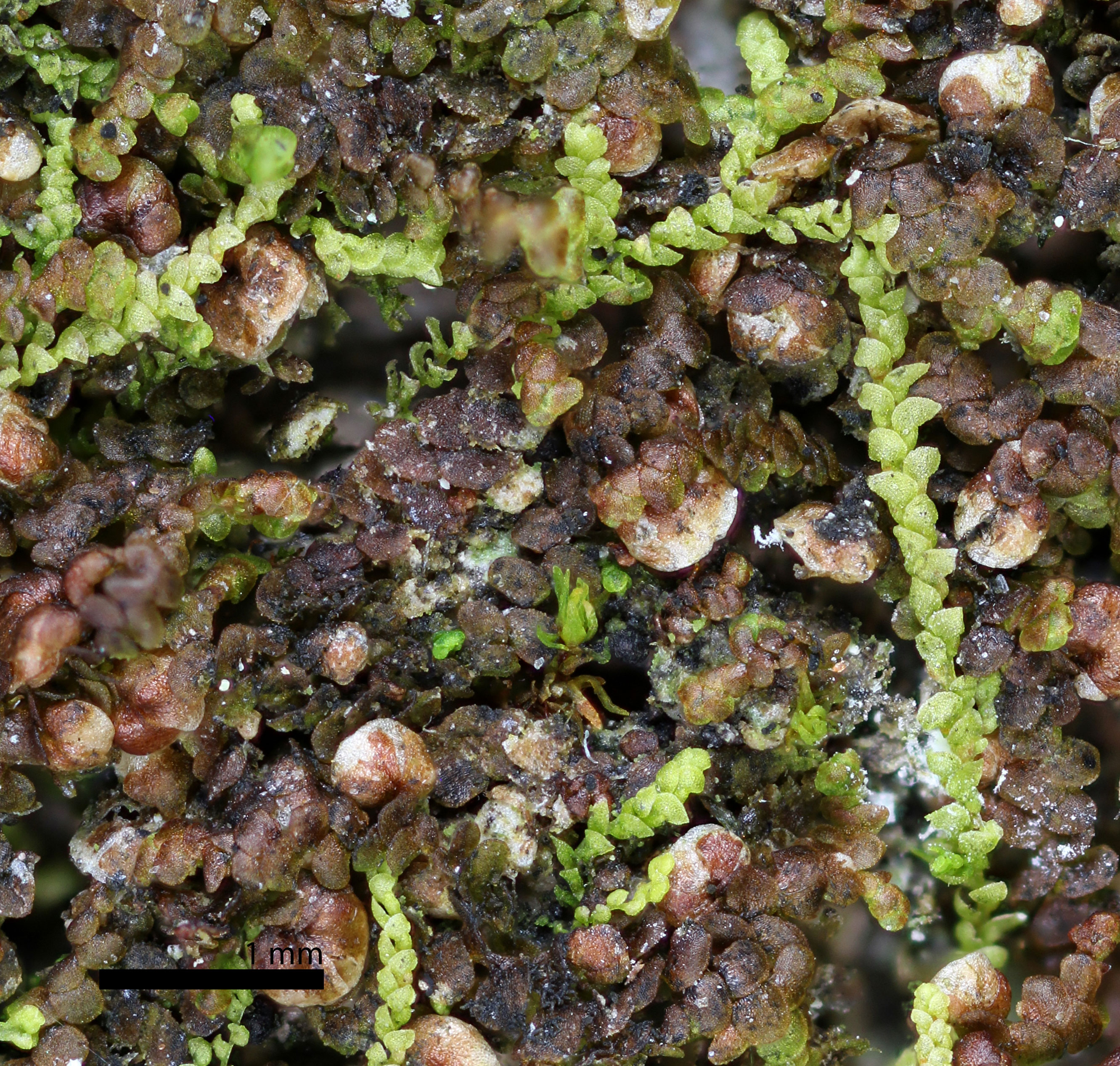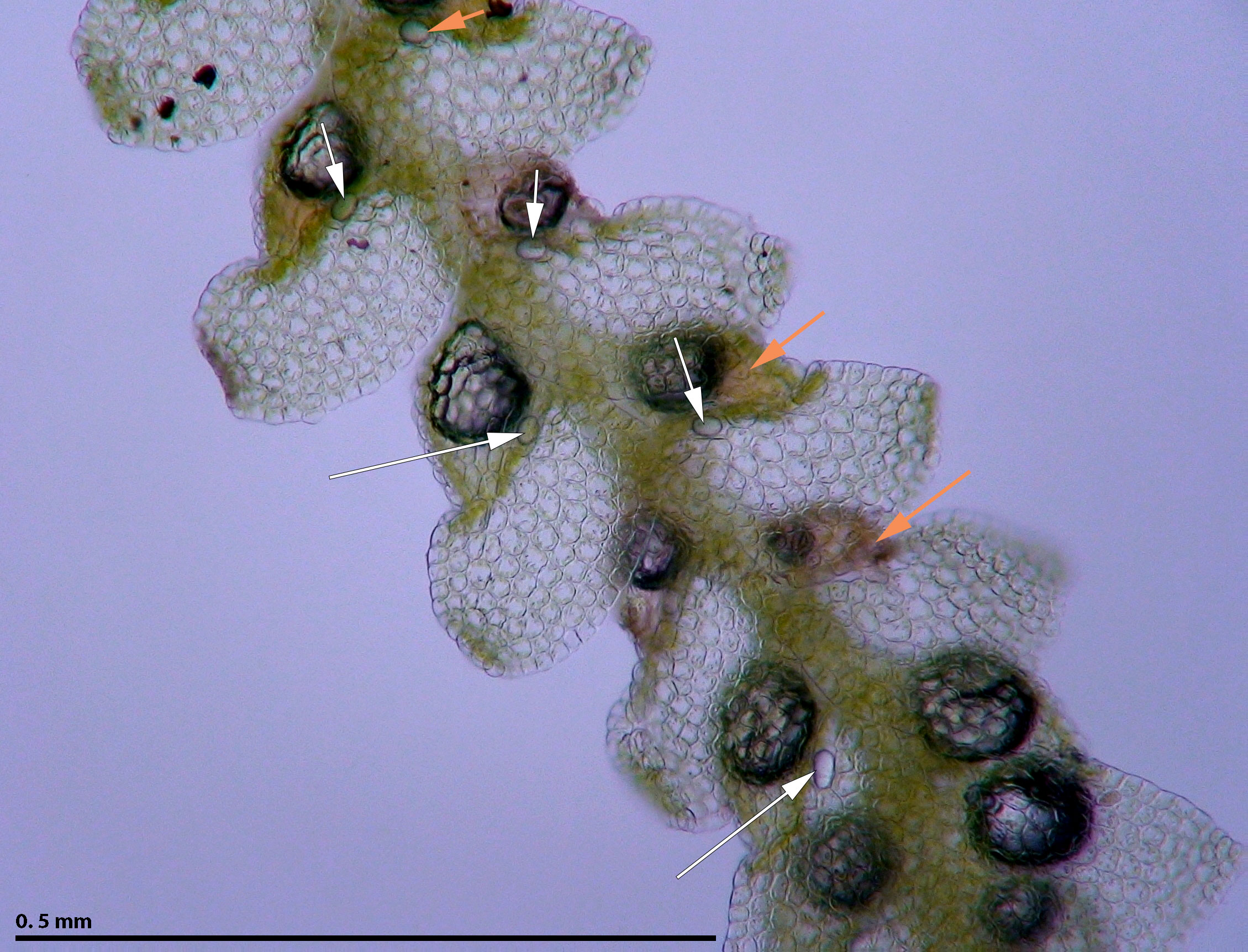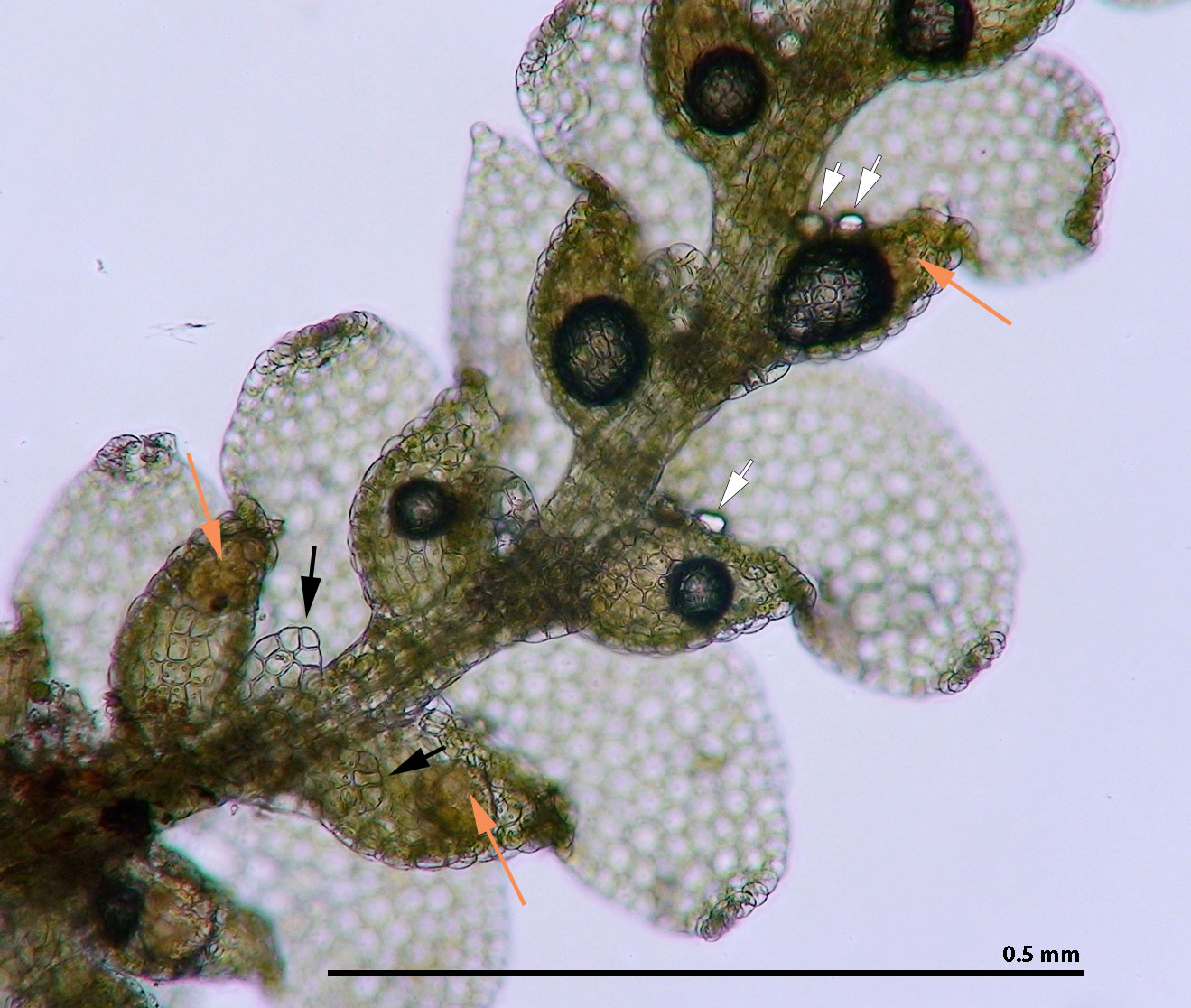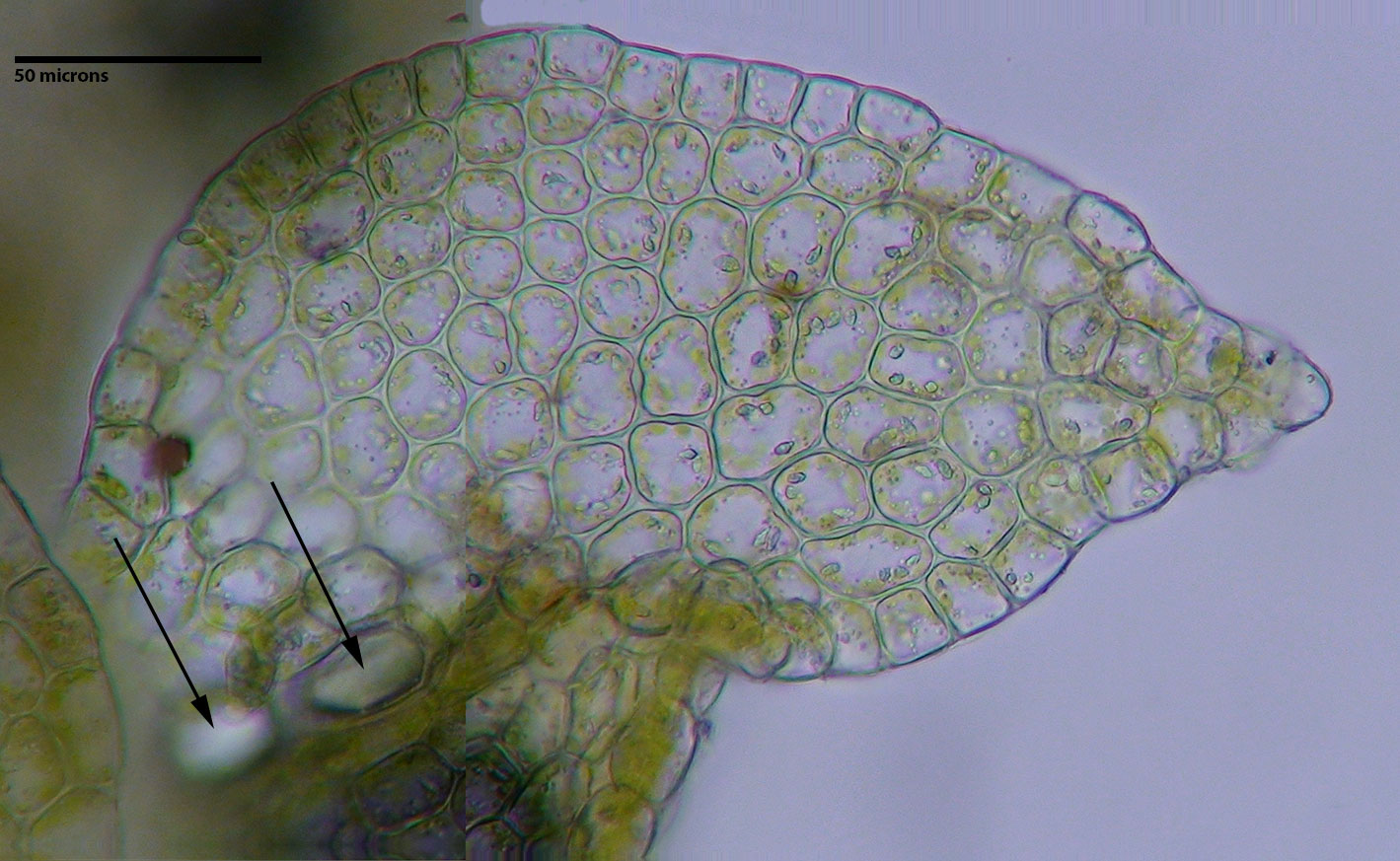Drepanolejeunea appalachiana R. M. Schuster
Family: Lejeuneaceae
Synonyms
Drepanolejeunea bidens subsp. appalachiana Schust., in Schuster and Hattori, Jour. Hattori Bot. Lab. No. 11: 43, 1954 (nomen nudum)
Drepanolejeunea appalachiana (Schust.) Bischl. ex Bischl., Rev. Bryol. et Lichén. 23 (1-2): 113, 1964 (without Latin diagnosis)
NatureServe Conservation Status
G2?
Distribution
North America. U.S.A.. (Georgia, Kentucky, North Carolina, South Carolina, Tennessee, Virginia, Puerto Rico). That the species occurs in Puerto Rico was doubted by Schuster (1980). Predominately a species of the Southern Appalachians with rare occurrences westward in the Appalachian Plateaus of northern Tennessee and eastern Kentucky.
Habitat
Acidic cove forests, upland mixed hardwood forests, and northern hardwood forests. Often near streams but also far from streams on trees in somewhat dry forests that experience frequent periods of high humidity; moderate to upper elevations (1100 ft. – 5000 ft.).
Drepanolejeunea appalachiana occurs on a wide range of woody plants. On twigs and trunks of shrubs: Alnus, Clethra, Leucothoe, and Rhododendron spp; bark of tree trunks: Amelanchier, Betula spp., Acer spp., Fagus, Ilex opaca, Liquidambar, Liriodendron, Nyssa, Quercus alba, Q. coccinea, Q. montana, Q. rubra, and Tsuga canadensis. Rarely on rock. In humid stream ravines where epiphyllous liverworts are found, D. appalachiana occurs on the leaves of Rhododendron maximum (Schuster 1959, Davison 1997). Sometimes found growing diffusely within the clumps of large, light loving, arboreal mosses, e.g. Leucodon brachypus and Schlotheimia lancifolia. Frequently found creeping over Frullania spp. and foliose lichens in corticolous communities.
Pure patches are not uncommon on the bark of younger trees, while scattered strands amongst other bryophytes are typical of older trees with rough bark. On young trees it appears to colonize the recessed crevices and slight irregularities of otherwise smooth bark. From these shaded micro-ravines of bark, shoots may spread out across the exposed flat bark surfaces forming pure patches of several square centimeters. Such robust, thin mats appear on trunks of young Liriodendron and other woody plants in close proximity to streams.
Brief Description and Tips for Identification
Occurring as isolated, prostrate shoots or shoots amassed forming thin mats. Individual shoots (leaves plus stem) 0.25 to 0.50 mm wide. Lateral leaves complicate-bilobed, the dorsal lobe falcate and quickly tapering to the apex (acuminate); one or two ocelli near the middle of some dorsal lobes of lateral leaves. Underleaves bilobed with wide spreading lobes, each lobe consisting of a single row of cells.
Apparently dioicous. Perianths apparently known only from Puerto Rico. Androecia unknown. Asexual reproduction presumably by wind-dispersed shoot fragments (including specially produced caducous branchlets).
Regionally, Harpalejeunea can be confused with Drepanolejeunea appalachiana given that both have pointed dorsal leaf lobes with ocelli; however, the dorsal leaf lobes of Harpalejeunea are acute rather than acuminate, ocelli are more numerous (typically 2-4 and contiguous), and underleaves lobes are several cells wide.
Though extremely small, D. appalachiana can be reliably identified in the field. The somewhat distant leaves with acuminate tips are distinctive.
Salient Features
- Ocelli located near middle of the dorsal lobe of some lateral leaves
- Underleaves bilobed with 1-cell wide, divaricate lobes.
- Dorsal lobe of lateral leaves narrowed to slender, falcate apex terminating in a single cell.
References
Davison, P. G. 1997. Epiphyllous liverworts newly discovered in the Southern Appalachians. Castanea, 215-218.
Schuster, R. M. 1959. Epiphyllous Hepaticae in the southern Appalachians. The Bryologist, 62(1), 52-55.
Schuster, R.M. 1967. North American Lejeuneaceae. X. Harpalejeunea, Drepanolejeunea, and Leptolejeunea. Journal of the Elisha Mitchell Scientific Society 83: 192–229.
Schuster, R.M. 1980. The Hepaticae and Anthocerotae of North America East of the Hundredth Meridian. Volume IV. Columbia University Press, New York
Thiers, B. M. 2016. Lejeuneaceae. Bryophyte Flora of North America, Provisional Publication.
Acknowledgment
Some text and images on this page were originally prepared for the Georgia Department of Natural Resources in 2010, contract number 605-090427 with Paul G. Davison and used here with permission.
Habitat
Habitat
Habit
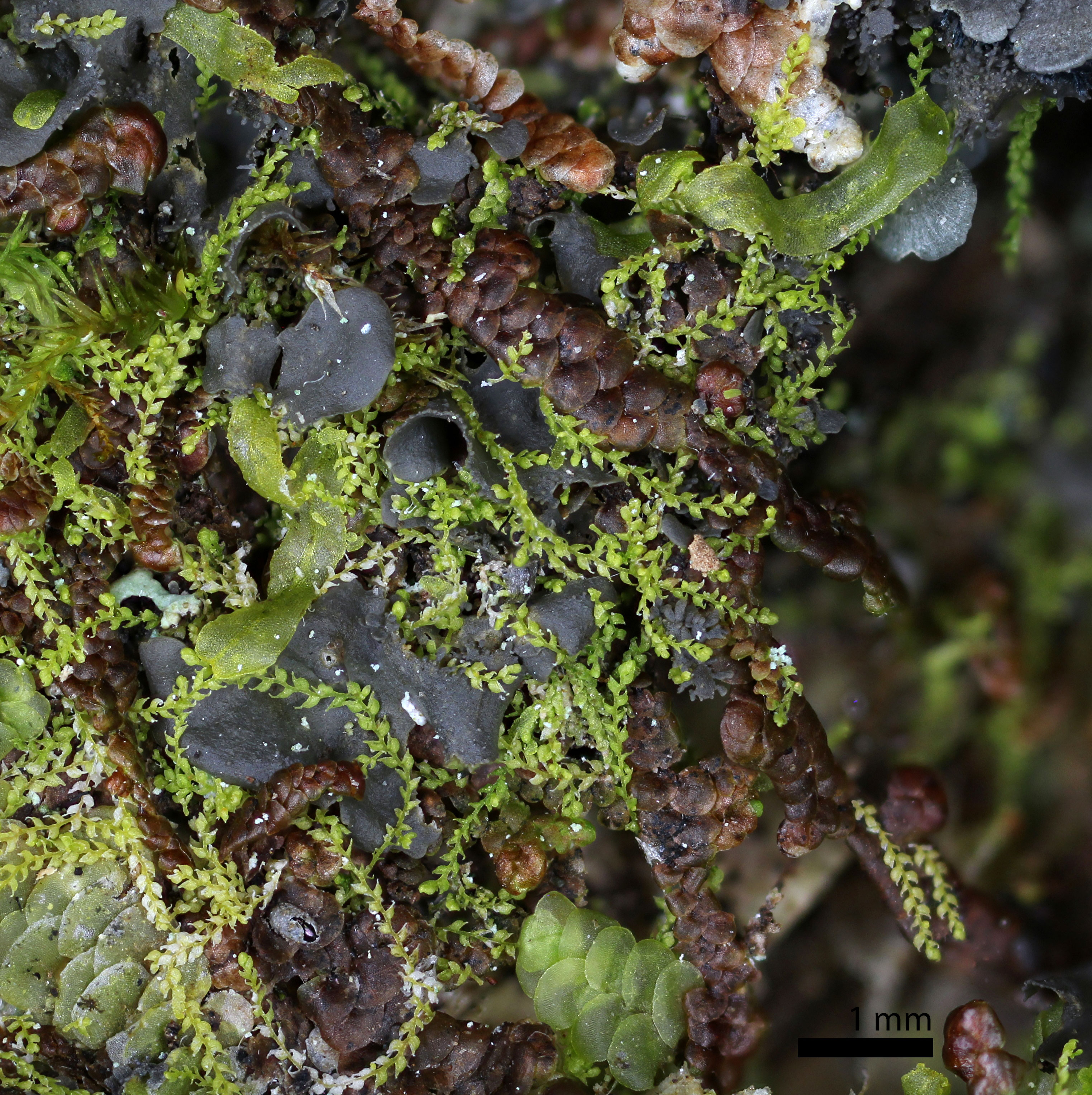
Drepanolejeunea appalachiana
On trunk of yellow birch with Frullania asagrayana, Metzgeria, Radula and lichens. Also present in this specimen packet: Harpalejeunea, Microlejeunea ulicina, Porella, and Frullania eboracensis. there are two shoots of Harpalejeunea in the photo; one shoot is out of focus at the far upper right, the other is near the top of the photo at the midline, shoot pointed down and angling to the left between Frullania shoots.
